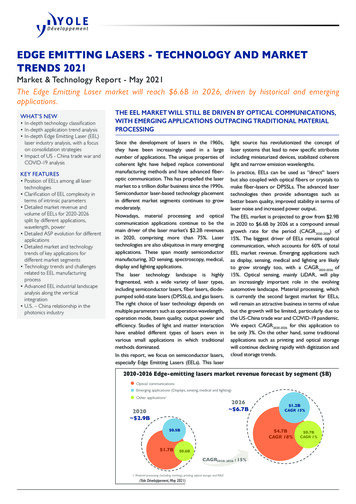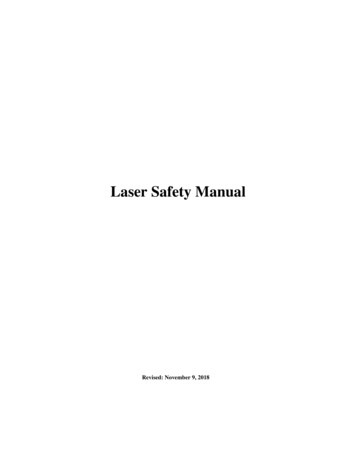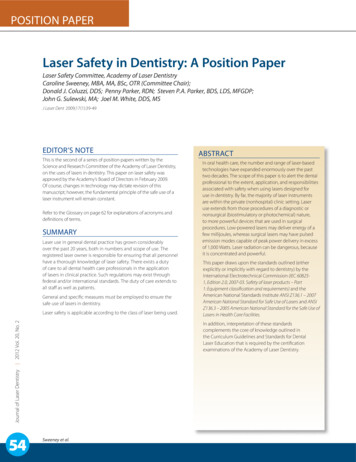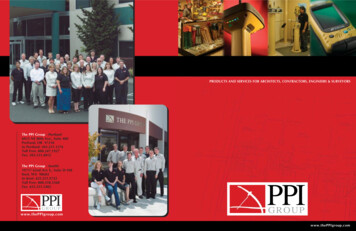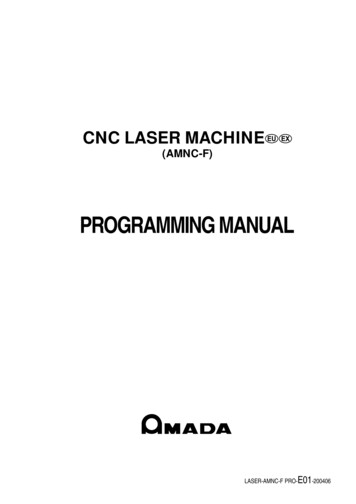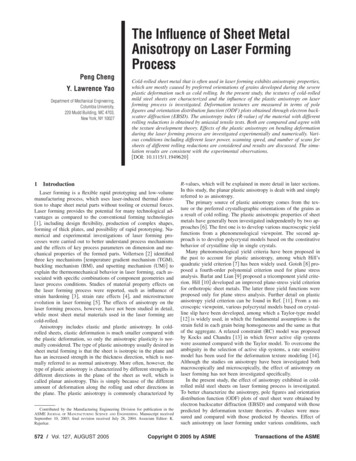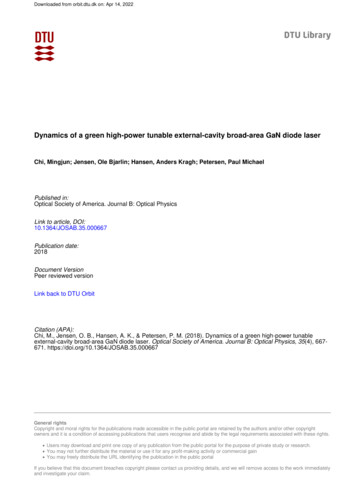
Transcription
Downloaded from orbit.dtu.dk on: Apr 14, 2022Dynamics of a green high-power tunable external-cavity broad-area GaN diode laserChi, Mingjun; Jensen, Ole Bjarlin; Hansen, Anders Kragh; Petersen, Paul MichaelPublished in:Optical Society of America. Journal B: Optical PhysicsLink to article, DOI:10.1364/JOSAB.35.000667Publication date:2018Document VersionPeer reviewed versionLink back to DTU OrbitCitation (APA):Chi, M., Jensen, O. B., Hansen, A. K., & Petersen, P. M. (2018). Dynamics of a green high-power tunableexternal-cavity broad-area GaN diode laser. Optical Society of America. Journal B: Optical Physics, 35(4), 667671. https://doi.org/10.1364/JOSAB.35.000667General rightsCopyright and moral rights for the publications made accessible in the public portal are retained by the authors and/or other copyrightowners and it is a condition of accessing publications that users recognise and abide by the legal requirements associated with these rights. Users may download and print one copy of any publication from the public portal for the purpose of private study or research. You may not further distribute the material or use it for any profit-making activity or commercial gain You may freely distribute the URL identifying the publication in the public portalIf you believe that this document breaches copyright please contact us providing details, and we will remove access to the work immediatelyand investigate your claim.
Dynamics of a green high-power tunable externalcavity broad-area GaN diode laserMINGJUN CHI,* OLE B. JENSEN, ANDERS K. HANSEN, AND PAUL M. PETERSENDTU Fotonik, , Department of Photonics Engineering, Technical University of Denmark, Frederiksborgvej 399, P.O. Box 49, DK-4000 Roskilde,Denmark*Corresponding author: mchi@fotonik.dtu.dkReceived XX Month XXXX; revised XX Month, XXXX; accepted XX Month XXXX; posted XX Month XXXX (Doc. ID XXXXX); published XX Month XXXXAlthough external-cavity feedback with a grating is widely used to achieve tunable high-power narrow-linewidthbroad-area diode laser (BAL) system, the dynamics of such system is seldom studied. In this paper, the temporaldynamics of a tunable high-power green external-cavity diode laser system based on a GaN BAL and Littrow externalcavity is investigated experimentally. The regular pulse package oscillation (PPO) is observed just above thethreshold. The oscillating period of the pulse package decreases with the increasing injected current. As the currentincreases further, the pulse package oscillates irregularly, and finally changes to a chaotic state. The PPO is observed,for the first time to our knowledge, in a BAL with an external-cavity grating feedback. 2017 Optical Society ofAmericaOCIS codes: (140.5960) Semiconductor lasers; (140.2020) Diode lasers; (190.3100) Instabilities and chaos.http://dx.doi.org/10.1364/AO.99.0999991. INTRODUCTIONSignificant progress has been achieved on GaN-based high power greendiode lasers since 2009 [1,2]. Today, green GaN broad-area diode lasers(BALs) with continuous-wave (CW) output power of more than 1 W arecommercially available [3]. The spectral bandwidth of these high-powerBALs is around 1 nm, and this broad emission bandwidth limits theapplication of these devices in many fields, such as laser holographicdisplay, biophotonics [4,5]. External-cavity feedback based on a gratingis a commonly used technique to achieve a tunable narrow-bandwidthhigh-power diode laser system [6-9]. Recently, we demonstrated a highpower tunable diode laser system based on Littrow external-cavityfeedback around 515 nm, where an output power of up to 480 mW anda tunable range of up to 9.2 nm was achieved, and the spectralbandwidth is around 9 pm with low output power and less than 0.25nm with high output power [10].When external-cavity feedback is applied to a diode laser, complextemporal dynamic behaviors will take place. The different dynamicbehaviors of BALs have been studied intensively with short-cavityfeedback [11-13], long-cavity feedback [14-16], tilt mirror feedback[17,18], and lateral-mode-selected feedback [19,20]. The feedbackelements in the external-cavity include ordinary mirrors [13-18], phaseconjugate mirror [14], and spatially filtered-mirrors [11,12,19,20].Different dynamic behaviors, such as self-pulsation [19], low frequencyfluctuations (LFFs) [14,15], periodic oscillations [17,20], pulse packageoscillation (PPO) [12,13,20] and chaos [16], have been observed in theBALs subjected to different external-cavity feedback.External-cavity grating feedback is widely used to achieve tunablehigh-power narrow-bandwidth BAL system. However, the dynamics ofsuch systems have only been studied in a very few cases [21]. Theresearch of the dynamics of BAL systems with external grating feedbackis important for both the basic laser physics and the application of sucha laser system.In this paper, we investigate the dynamics of the tunable high-powergreen diode laser system developed recently [10]. As the injectedcurrent increases, we observe the regular PPO, irregular PPO, andchaotic state. To the best of our knowledge, this is the first observationof PPO, and the transition from PPO to chaos in a grating external-cavityfeedback BAL system.2. EXPERIMENTAL SETUP AND RESULTSThe experimental setup of the green external-cavity diode laser systemis schematically shown in Fig. 1, and a detailed description of the setuphas been given in Ref. [10]. The gain device in the diode laser system isa 1 W GaN broad-area diode laser around 515 nm (Nichia). Anaspherical lens of 4.0 mm focal length is used to collimate the outputbeam from the BAL. The collimated beam is incident on a bulk reflectiveholographic grating with a groove density of 2400 lines/mm (Thorlabs,GH13-24U). The first-order diffracted beam from the grating is guidedback into the diode laser as feedback beam. A half-wave plate is used toswitch the polarization direction of the laser beam incident upon thegrating. A beam splitter, BS1, (R 1%) is inserted in the external cavity,and reflects part of the beam to a silicon PIN photodiode, PD1, (MellesGriot, 13DAH001); after a high-frequency amplifier (frequency below 1MHz is blocked), the amplified electronic signal is sent to an electricalspectrum analyzer (Tektronix 2753P) to measure the intensity noisespectrum. The zeroth-order diffracted beam from the grating is theoutput of the laser system. The second beam splitter, BS2, reflects partof this beam to the second photodiode, PD2, (Thorlabs, DET210), and a
1-GHz digital oscilloscope (LeCroy, WaveSurfer 104 Xs) is used tomeasure the time series of the generated electronic signal.moderate feedback strength for BALs [14,20]. The physical length of theexternal cavity is around 33 cm.The threshold current of the freely running BAL is around 250 mA,and the slope efficiency is around 1.0 W/A; 1.1 W output power isobtained with an operating current of 1.4 A. When the external-cavitydiode laser system is operated in p-polarized mode, the threshold isdecreased to 205.5 mA, and the wavelength is around 511.9 nm. In theexperiment, we keep the feedback grating untouched, i.e., both thelength of the external cavity and the wavelength of the green externalcavity laser system are unchanged when the injected current isadjusted.Fig. 1. Experimental setup of the Littrow external-cavity green diodelaser system for dynamics investigation. BAL, broad-area diode laser; L,lens; BS1 and BS2, beam splitters; HWP, half-wave plate; G, holographicgrating; PD1 and PD2, photodiodes; DO, digital oscilloscope; Am,amplifier; ESA, electrical spectrum analyzer.(a)2,03,02,0I 211 mA1,52,51,02,00,52132282432582731,01,50,81,60,6I 207.5 mA1,20,4630640650660670680Power (au)Power (au)(a)0,80,41,00,53,5(b)3,02,5I 213 mA2,01,51,00,002004006008001000Time (ns)35Intensity (dB)28(b)0,52102202302402502,0I 207.5 mA LFO1,51,0 EC and C LFO212,50,5140100200300400500Time (ns)7Fig. 3. Time series of the output beam from the external-cavity greendiode laser system with an injected current of 211 mA (a) and 213 mA(b). The insets show a close up of one of the pulse packages.0-70,00,20,40,60,8Frequency (GHz)Fig. 2. Time series (a) and intensity noise spectrum (b) of output beamfrom the external-cavity green diode laser system with an injectedcurrent of 207.5 mA. The inset in (a) shows a close up of the peak of oneof the pulse packages.In this paper, the green BAL system is operated in p-polarized mode,i.e., the laser beam is polarized perpendicular to the lines of the grating[10]. Thus the first-order diffraction efficiency of the grating is around29% [10]. Assuming the coupling efficiency of the feedback beam intothe laser cavity is 0.5, the feedback strength is around 14.5%, aFig. 2(a) shows the time series of the output beam with an injectedcurrent of 207.5 mA. A low-frequency periodic oscillation is observedwith a frequency around 7.2 MHz. The inset of Fig. 2(a) shows the detailsof the time series in short time scale. An oscillation with a period around2.4 ns is observed. Considering the physical length of the external-cavityand the thickness and refractive index of the lens, half-wave plate andbeam splitter, the period of this high frequency oscillation is equal to theexternal-cavity delay time, i.e., 2L/c, where c is the speed of light and L isthe optical external-cavity length. The high frequency oscillation isnamed as external-cavity oscillation with the single-round trip externalcavity frequency νEC c/2L, [13,20]. Fig. 2(b) shows the correspondingintensity noise spectrum of the output beam. Besides the peaks at the
1812I 340 mAI 250 mA6004080120160200Time (ns)Fig. 5. Time series of the output beam from the external-cavity greendiode laser system with different injected currents.(a) I 230 mA204080120160200Time (ns)40(b)30 LFO201000,0I 420 mA3040I 420 mA24 ECI 230 mAIntensity (dB)Power (au)30356Intenisty (dB)the laser system is more complex. This is consistent with the time seriesof irregular PPO shown in Fig. 4 (a).Power (au)external-cavity oscillation frequency, νEC, a peak around 7.2 MHz and itsharmonics for low frequency oscillation (LFO), νLFO, is also observed.Additionally, some peaks around νEC with the frequency difference ofνLFO are also visible. Fig. (2) shows that the output of the green externalcavity diode laser manifests a typical dynamic state named regular PPOwhich mainly takes place in short-cavity feedback diode laser system[12,13], where the external-cavity loop oscillation is modulated by aperiodic LFO.Fig. 3 shows the time series of the output beam of the diode lasersystem with injected currents of 211 mA and 213 mA. The periodic LFOis observed for both cases. The oscillation frequencies are around 20and 29 MHz with the injected currents of 211 mA and 213 mA,respectively. The insets in the figure show the details of one period ofthe regular LFOs, i.e., one of the pulse packages. The pulse packages,which consist of pulses occurring at the external-cavity round tripinterval, are observed for both condition. This means the regular PPOtakes place for both cases. Fig. 2 and Fig. 3 shows the oscillationfrequency of the regular LFO, νLFO, increases with the increase of theinjected current to the BAL. The increase of νLFO with injected currentwas also observed in an integrated semiconductor laser operated inshort cavity feedback regime [22]. The corresponding intensity noisespectra with these two injected currents are also measured, the resultsbeing similar to the noise spectrum shown in Fig. 2(b), and consistentwith the time series shown in Fig. 3.25201510500,00,30,60,91,21,51,8Frequency (GHz)Fig. 4. Time series (a) and intensity noise spectrum (b) of the outputbeam from the external-cavity green diode laser system with an injectedcurrent of 230 mAWhen the injected current is further increased, the pulse packagesoscillate irregularly. Fig. 4 shows the time series and the intensity noisespectrum of the output beam from the green external-cavity BALsystem operated with injected current of 230 mA. The time series stillshows the pulse packages consisting of pulse train with the period ofexternal-cavity delay time. However, the oscillation of the pulsepackages is irregular, and the period of the pulse packages is decreasedfurther, the average duration of the pulse packages shown in Fig. 4(a) isless than 30 ns. The corresponding intensity noise spectrum in Fig. 4(b)shows the broad peak for LFO at νLFO, and peaks for high frequencyexternal-cavity oscillation at multiples of νEC. But the peaks at νEC νLFOoriginating from the mixing of external cavity loop frequency νEC andLFO frequency νLFO, which is the indication of regular PPO, are notobserved. All the peaks shown in Fig. 4(b) are much broader comparedwith the intensity noise spectrum shown in Fig. 2(b). This means thatthe intensity noise is increased strongly, and the dynamic behavior of0,30,60,91,21,51,8Frequency (GHz)Fig. 6. Intensity noise spectrum of the output beam from the externalcavity green diode laser system with an injected current of 420 mA.We increase the injected current to 420 mA, i.e., more than twice thethreshold of the BAL system, and measure the time series and theintensity noise spectra of the output of the laser system. Fig. 5 shows thetime series with injected currents of 250, 340, and 420 mA. When theinjected current is 250 mA, the time series shows irregular PPO, thefrequency component of the high frequency external-cavity oscillationis not as clear as in the cases with lower injected currents. The averageduration of the pulse package is less than 20 ns, meaning that theoscillation of the pulse package is faster compared with the cases withlower injected currents. The pulse package is not clear when the injectedcurrent is increased to 340 mA, and the pulses occurring at the externalcavity round trip interval is almost invisible. Finally, the time seriesshows a chaotic behavior with an injected current of 420 mA. Thecorresponding intensity noise spectrum of the output beam with theinjected current of 420 mA is shown in Fig. 6. The broad intensity noisespectrum from low frequency to high frequency indicates typicalfeatures of chaotic dynamics of the output beam. This is consistent withthe chaotic time series shown in Fig. 5.
3. DISCUSSIONThe fast dynamic behavior is seldom investigated in a BAL with gratingfeedback. Pan et al. studied the dynamics of a BAL with grating feedback[21] by measuring the time series at different positions at the near field.When the injected current was low, a period-one oscillation wasobserved, and when the injected current was higher than 1.5 timesthreshold, chaotic dynamics was observed. Here we observe regularPPO in the green external-cavity diode laser system with injectedcurrents near the threshold and an increase of oscillation frequency ofthe pulse packages with injected current.Regular PPO was first observed by Heil et al. in 2001 in externalcavity feedback narrow strip diode laser systems [23]. The origin of PPOis the state of the laser wanders among the external-cavity modes andexternal-cavity anti-modes repeatedly, a result of saddle-nodeinstability caused by external feedback [23,24]. This phenomenonmainly takes place in diode lasers with short-cavity feedback [12,13], i.e.,when the relaxation oscillation frequency, νRO, of the solitary diode laseris lower than νEC. In practice, a length of the external-cavity around a fewcentimeters or less means short cavity feedback. Recently, we observedregular PPO in a BAL with a lateral-mode-selected long-cavity feedback[20]. Here, regular PPO is observed in a BAL with grating external-cavityfeedback for the first time to our knowledge.In the regular PPO condition, both the experimental and theoreticalresults showed the increase of LFO frequency νLFO with injected current[22,24], similar results are also observed in our experiment. When theinjected current is increased further, the pulse packages first oscillateirregularly, and finally change to a chaotic state. The chaotic state withhigh injected current is similar to the observation in Ref. 21. Differentroutes to chaos in different diode laser systems have been found, suchas period-doubling route to chaos in narrow-stripe single mode diodelaser [25], period-doubling and quasiperiodic route to chaos in spinpolarized vertical-cavity surface-emitting laser [26]. Here, we observethe transition from regular PPO to chaos in a BAL with grating externalfeedback for the first time to our knowledge.Normally, the LFO frequency of regular PPO is in the range of a fewhundreds of MHz to a GHz [12,13,20,22,23]. Our experiment on thegreen external-cavity BAL system shows the LFO frequency is in therange from a few MHz to a few tens of MHz, much lower than theprevious results. There may be two reasons for the slow LFO, since thelength of the external-cavity here is around 10 times of cavity length forshort cavity condition, the external-cavity oscillation period in a pulsepackage, i.e., 2L/c, is also around 10 times of the oscillation period ofshort cavity. The second reason is, due to the long external cavity, moreexternal-cavity modes can be excited, the laser system may visit moreexternal-cavity modes during one PPO cycle [23,24].Depending on the length of external cavity, the external-cavityfeedback for diode laser system is classified into two regimes: short andlong cavity regimes. When the relaxation oscillation frequency of thesolitary diode laser, νRO, is lower than νEC, the feedback is in short cavityregime; otherwise, it is in long cavity regime [22-24]. With moderatefeedback strength, the PPO mainly takes place in diode laser with shortcavity feedback, while LFF and chaos take place in long cavity regime.The transition from the short to long cavity regime can be achieved byincreasing either the length of external cavity [13] or the injectedcurrent [22]. Normally, an external-cavity length of a few centimetersmeans short cavity feedback, in this point, the 33 cm external-cavitylength in our case is in the long cavity regime. The νRO of the solitarydiode laser is proportional to the square root of the difference betweenthe injected current and the solitary laser threshold current [22], meansthe definition of νRO is valid only when the injected current is above thethreshold current. Thus, the classification of short and long cavityfeedback is meaningful only when the injected current is higher than thethreshold of the solitary diode laser. In our case, the PPO mainly takesplace with the injected current below the threshold of the solitary laser.In this point, this is a new regime for the external-cavity diode lasersystem. Theoretical research on the dynamics of diode laser withexternal-cavity feedback in this regime, i.e., below the threshold ofsolitary laser, is undergoing.4. CONCLUSIONIn conclusion, the dynamic behavior of a high-power green BAL withgrating external-cavity feedback is investigated. As the injected currentis increased, different dynamic behaviors from regular PPO, irregularPPO to broadband chaos are observed. It is the first time that regularPPO and the transition from regular PPO to chaos has been observed ina grating external-cavity BAL system.Funding information. Danish Energy Technology Development andDemonstration Program (EUDP) (64014-0171)References1. T. Miyoshi, S. Masui, T. Okada, T. Yanamoto, T. Kozaki, S. Nagahama, and T.Mukai, “510-515 nm InGaN-based green laser diodes on c-plane GaNsubstrate,” Appl. Phys. Express 2, 062201 (2009).2. A. Avramescu, T. Lermer, J. Müller, S. Tautz, D. Queren, S. Lutgen, and U.Strauβ, “InGaN laser diodes with 50 mW output power emitting at 515nm,” Appl. Phys. Lett. 95, 071103 (2009).3. http://www.nichia.co.jp4. J. Hofmann, G. Blume, D. Jedrzejczyk, B. Eppich, D. Feise, S.Kreutzmann, A. Sahm, and K. Paschke, “Miniaturized diode lasermodule emitting green light at 532 nm with a power of more than900 mW for next-generation holographic displays,” Opt. Rev.23,141-145 (2016).5. A. Müller, S. Marschall, O. B. Jensen, J. Fricke, H. Wenzel, B. Sumpf,and P. E. Andersen, “Diode laser based light sources for biomedicalapplications,” Laser Photonics Rev. 7, 605-627 (2013).6. J. F. Sell, W. Miller, D. Wright, B. V. Zhdanov, and R. J. Knize, “Frequencynarrowing of a 25 W broad area diode laser,” Appl. Phys. Lett. 94, 051115(2009).7. M. Chi, G. Erbert, B. Sumpf, and P. M. Petersen, “Tunable high-powernarrow-spectrum external-cavity diode laser based on tapered amplifier at668 nm,” Opt. Lett. 35, 1545-1457 (2010).8. N. Ruhnke, A. Müller, B. Eppich, M. Maiwald, B. Sumpf, G. Erbert, and G.Tränkle, “400 mW external cavity diode laser with narrowband emission at445 nm,” Opt. Lett. 39, 3794-3797 (2014).9. M. Chi, O. B. Jensen, and P. M. Petersen, “Tuning range and output poweroptimization of an external-cavity GaN diode laser at 455 nm,” Appl. Opt.55, 2263-2269 (2016).10. M. Chi, O. B. Jensen, and P. M. Petersen, “Green high-power tunableexternal-cavity GaN diode laser at 515 nm,” Opt. Lett. 41, 4154-4157(2016).11. S. K. Mandre, I. Fischer, and W. Elsӓsser, “Control of the spatiotemporalemission of a broad-area semiconductor laser by spatially filteredfeedback,” Opt. Lett. 28, 1135-1137 (2003).12. S. K. Mandre, I. Fischer, and W. Elsӓsser, “Spatiotemporal emissiondynamics of a broad-area semiconductor laser in an external cavity:stabilization and feedback-induced instabilities,” Opt. Commun. 244, 355365 (2005).13. A. Takeda, R. Shogenji, and J. Ohtsubo, “Dynamics and pulse-packageoscillations in broad-area semiconductor lasers with short opticalfeedback,” Appl. Phys. Lett. 101, 231105 (2012).14. J. S. Lawrence and D. M. Kane, “Broad-area diode lasers with plane-mirrorand phase-conjugate feedback,” J. Lightwave Technol. 20, 100-104 (2002).15. Y. Fujita and J. Ohtsubo, “Optical-feedback-induced stability and instabilityin broad-area semiconductor lasers,” Appl. Phys. Lett. 87, 031112 (2005).
16. M. Arahata and A. Uchida, “Inphase and antiphase dynamics of spatiallyresolved light intensities emitted by a chaotic broad-area semiconductorlaser,” IEEE J. Sel. Topics Quantum Electron. 21, 1800609 (2015).17. P. P. Vasil’ev and I. H. White, “Phase-conjugation broad area twin-contactsemiconductor laser,” Appl. Phys. Lett. 71, 40-42 (1997).18. T. Tachikawa, R. Shogenji, and J. Ohtsubo, “Observation of multi-pathinterference in broad-area semiconductor lasers with optical feedback,”Opt. Rev. 16, 533-539 (2009).19. S. Wolff, A. Rodionov, V. E. Sherstobitov, C. Doering, H. Fouckhardt, “Selfpulsation in broad-area lasers with transverse-mode selective feedback,”Opt. Commun. 265, 642-648 (2006).20. M. Chi and P. M. Petersen, “Dynamics of a broad-area diode laser withlateral-mode-selected long-cavity feedback,” J. Appl. Phys. 116, 103101(2014).21. M. Pan, D. J. Evans, G. R. Gray, L. M. Smith, R. E. Benner, C. W. Johnson,and D. D. Knowlton, “Spatial and temporal coherence of broad-area laserswith grating feedback,” J. Opt. Soc. Am. B 15, 2531-2536 (1998).22. J. P. Toomey, D. M. Kane, C. McMahon, A. Argyris, and D. Syvridis,“Integrated semiconductor laser with optical feedback: transition fromshort to long cavity regime,” Opt. Express 23, 18754-18762 (2015).23. T. Heil, I. Fischer, W. Elsӓβer, and A. Gavrielides, “Dynamics ofsemiconductor lasers subject to delayed optical feedback: the short cavityregime,” Phys. Rev. Lett. 87, 243901 (2001).24. T. Heil, I. Fischer, W. Elsӓβer, B. Krauskopf, K. Green and A. Gavrielides,“Delay dynamics of semiconductor lasers with short external cavities:Bifurcation scenarios and mechanisms,” Phys. Rev. E 67, 066214 (2003).25. J. Ye, H. Li, and J. G. McInerney, “Period-doubling route to chaos in asemiconductor laser with weak optical feedback,” Phys. Rev. A 47, 22492252 (1993).26. N. Li, H. Susanto, B. R. Cemlyn, I. D. Henning, and M. J. Adams, “Stability andbifurcation analysis of spin-polarized vertical-cavity surface-emittinglasers,” Phys. Rev. A 96, 013840 (2017).
The gain device in the diode laser system is a 1 W GaN broad-area diode laser around 515 nm (Nichia). An aspherical lens of 4.0 mm focal length is used to collimate the output beam from the

